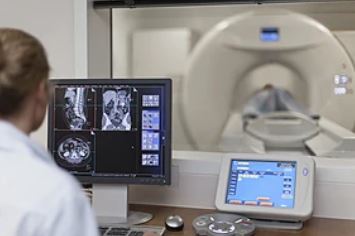Every 90 minutes someone new is diagnosed with amyotrophic lateral sclerosis (ALS). You’ve heard these letters before. You may even know a famous person who has been diagnosed with it. But what exactly is it?
Amyotrophic lateral sclerosis, better known as ALS, is a progressive neurological disease that affects the motor neurons in the brain and spinal cord that control voluntary muscle movement and causes cells to break down and die resulting in disability. The terminology A-myo-trophic comes from the Greek language, where “A” means no, “Myo” refers to muscle, and “Trophic” means nourishment – “No muscle nourishment.” When a muscle has no nourishment, it “atrophies” or wastes away. “Lateral” refers to the areas in a person’s spinal cord where some parts of the nerve cells that signal and control the muscles are located. As this area degenerates, it leads to scarring or hardening (“sclerosis”) in the region. The death of these motor neurons, progressively affect voluntary muscle action and people may lost the ability to speak, eat and breathe.
ALS is often referred to as Lou Gehrig’s disease, which is named after the famous baseball player who was diagnosed with it. Other notable people who have been diagnosed with ALS include physicist and author Steven Hawking, Hall of Fame pitcher Jim “Catfish” Hunter, Toto bassist Mike Porcaro, “Sesame Street” creator Jon Stone and former Vice President Henry A. Wallace. Although doctors don’t really know exactly why ALS occurs, there are a few early symptoms that help them to identify the disease.
Causes
French neurologist Jean-Martin Charcot discovered the disease in 1869. There are two different types of ALS, sporadic and familial. Sporadic is the most common form of the disease in the U.S. and accounts for 90 to 95 percent of all cases. It may affect anyone, anywhere. Familial ALS (also known as FALS) accounts for 5 to 10 percent of all cases in the U.S. Familial ALS means the disease is inherited. In those families, there is a 50% chance that the children will inherit the gene mutation and may develop the disease. Studies reveal several possible causes of ALS, including:
-
Gene Mutation
-
Chemical Imbalance
-
Protein mishandling
-
Disorganized immune response
Symptoms
Initial symptoms of ALS can vary among individuals, there is always some progression of motor weakness, that is generally painless. Here are some other common patterns that develop gradually. These include:
-
Difficulty with everyday motor movement like walking or picking up a coffee cup
-
Changes in speech, such as strained or hypernasal voice, and slurred speech
-
Muscle cramps with arm, shoulder or tongue twitching
-
Weakness in leg, feet or ankles
-
Difficulty holding head up or keeping proper posture
-
Tripping and falling
-
Uncontrollable periods of laughing or crying
As the disease begins to progress, it spreads to other parts of the body and your muscles progressively weaken and paralysis ensues. This eventually will affect a person’s ability to chew, swallow, speak and breathe, ultimately requiring ventilation support to assist with breathing. The rate at which ALS progresses vary from one person to the next. Although the mean survival time with ALS is three to five years, many people live five, 10 or more years. ALS doesn’t usually affect your bowel or bladder control, your senses or your thinking ability. Since ALS attacks only motor neurons, your senses are generally unaffected, meaning you can still see, touch, taste, hear and smell like normal. This makes it possible to remain actively involved with your family and friends.
Risk Factors
Although the majority of cases for ALS are not known, there are some established risk factors to be aware of.
-
Hereditary – Inherited by approx 5-10% of those with ALS. Most people with familial ALS have a 50% chance of developing the disease.
-
Age – Risk increases with age, and most commonly diagnosed from ages 40-60. Before the age of 65, men develop ALS slightly more than women.
-
Genetics – Some studies examining the entire human genome found similar genetic variations of people with familial ALS and some people with sporadic ALS, making those with these genetic variations more susceptible to developing the disease.
-
Smoking – likely the only environmental factor for ALS and typically with greater risk for women than men, particularly after menopause.
-
Environmental Toxin Exposure – some evidence suggests exposure to lead or other substances may be linked to ALS. Although many studies have been done, no single agent or chemical has been linked to ALS.
-
Military Service – Recent studies reveal that people who have served in the military are at higher risk of ALS. Although it’s unclear what in about military service may result in the development of ALS, it is thought to include exposure to certain metal or chemicals, traumatic injuries, viral infections and intense exertion.
Diagnosis
 ALS is difficult to diagnose as there is no one test or procedure to ultimately determine the diagnosis of ALS. It is through the use of differential diagnosis and ruling out other diseases, that a diagnosis is established. A comprehensive diagnostic workup includes most, if not all, of the following procedures:
ALS is difficult to diagnose as there is no one test or procedure to ultimately determine the diagnosis of ALS. It is through the use of differential diagnosis and ruling out other diseases, that a diagnosis is established. A comprehensive diagnostic workup includes most, if not all, of the following procedures:
-
Electrodiagnostic tests, including electromyography (EMG) and nerve conduction velocity (NCV)
-
Blood and urine studies, including high resolution serum protein electrophoresis, thyroid and parathyroid hormone levels and 24 hour urine collection for heavy metal
-
Spinal tap
-
X-rays, including magnetic resonance imaging (MRI)
-
Myelogram of cervical spine
-
Genetic tests for those with familial ALS (FALS)
-
Muscle and/or nerve biopsy
-
A thorough neurological examination
Tests are run at the discretion of the neurologist, or ALS specialist, based on the results of other diagnostic tests and physical examination. Full diagnostic testing currently takes approximately 12 to 14 months to receive a diagnosis. There are some diseases that have similar symptoms of ALS and are treatable, so the ALS Association recommends getting a second opinion from someone who has training in this medical specialty.
Prognosis
At present, there is no cure for ALS. Most people live with ALS for 2-5 years after the initial onset of the disease, but about 10% of people with ALS survive at least 10 years. This variable rate of disease progression makes it difficult to predict the prognosis, and determine which therapies to develop. There are currently 2 FDA medications approved for treatment – Riluzole and Radicava, which have not been proven to stop the disease, but have had some impact on the progression of the disease. Research and drug development continue to be of urgent medical need according to the ALS Therapy Development Institute which states,
“ALS is not an incurable disease. It is an underfunded one.”
For additional research on treatments to consider for ALS patients, click here. If you or your loved one has ALS, schedule an appointment today and let us show you how to make the most of your function and adapt to your deficits.
The information you need . . . Straight Up!

